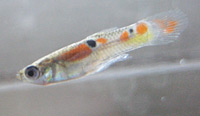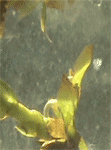The key is light. Light drives the carbon cycle.
 The plants use the carbon dioxide gas and sunlight to grow (make more plant cells). They also give off oxygen gas. This is called photosynthesis.
The plants use the carbon dioxide gas and sunlight to grow (make more plant cells). They also give off oxygen gas. This is called photosynthesis.- The fish and snails can use the plant for food (or eat other organisms that eat the plant).
- The fish and snails breathe in oxygen gas and use it to change food into energy. They also give off carbon dioxide gas. This is called respiration.
But where's the oxygen and carbon dioxide gas? How do we know it's in the water?
We have some evidence and information that gases can dissolve in water.We know that living things need oxygen to survive and plants need carbon dioxide to grow. Since they survive for a long time in closed ecosystem we can infer there are O2 and CO2 in the water.
 |
| Watch the oxygen bubbles rising from this aquatic plant. |
If you look at the plants when the sun is on them you can often see bubbles coming off. When we open a bottle of soda, bubbles quickly come out of the liquid. This shows there are gases dissolved (they are actually CO2 bubbles).
There are also equipment and chemical tests that can be done to test the amount of O2 and CO2 in water.
All of this strongly supports the idea that there are gases dissolved in water.
What would happen if...
Using the image of the carbon cycle above, try to answer the questions below. This will really help you learn and remember how the carbon cycle works! Read the question, think about it, and then look at the answer.[Image of bottle ecosystem with arrows showing the movement of carbon. Animated gif would be nice. The info and then the arrows darkening or something.]
What happens to the ecosystem if we: (click question to uncover answer)- Cover it with a blanket?
Answer: Without sunlight, plants couldn't change carbon dioxide into oxygen gas. As a result, the animals would die once they used all the available oxygen. Eventually, the plants would die since they also use oxygen. In addition, they would run out of carbon dioxide and couldn't make food or grow.
- Take away the plants?
Answer: Plants use sunlight to transform CO2 into food. They give off O2 gas in the process. Without O2 the animals would die.
- Take away the animals and microorganisms?
This is a bit complicated and worthy of an experiment. Plants use sunlight and CO2 to make food and grow. They also use oxygen to carry out cellular activities. It's likely that without animals or microorganisms, the plant would live for a while. But it wouldn't be able to grow since there would be no additional CO2 available. Any leaves that fell off the plant would just fall to the bottom. Without decomposers or something to eat the leaves they could not be transformed back into CO2 for the plant to use.
- Add more fish and snails?
 Answer: This would be an interesting experiment. On one hand, a few more animals might use the oxygen produced by plants more quickly. That might allow the plants to grow quicker. On the other hand, in this closed system there is a constant amount of both carbon and oxygen. Too many animals might use the oxygen too quickly and die. Ecosystems need to be balanced and too many fish and snails could disturb the balance.
Answer: This would be an interesting experiment. On one hand, a few more animals might use the oxygen produced by plants more quickly. That might allow the plants to grow quicker. On the other hand, in this closed system there is a constant amount of both carbon and oxygen. Too many animals might use the oxygen too quickly and die. Ecosystems need to be balanced and too many fish and snails could disturb the balance.
- Add more plants?
Answer: More plants would mean carbon dioxide could be transformed into oxygen gas faster. This might mean that the ecosystem could support larger animals or more animals. Fish and snails could reproduce or grow larger. This is especially the case if the fish and snails eat the plants or the small organisms that feed on the plants. But if there are so many plants that they can't get enough sunlight this could result in some of the plants dying.





